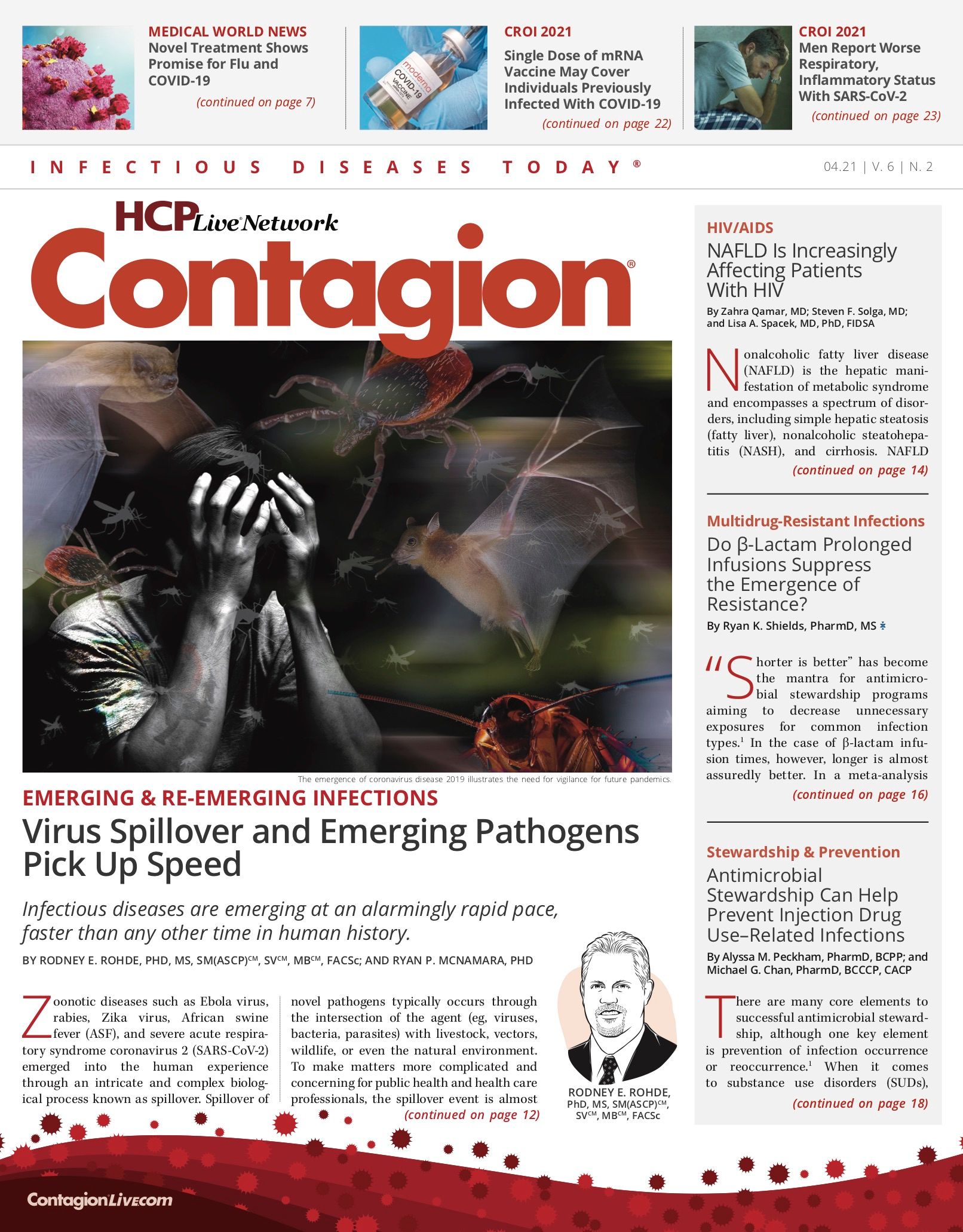Advances in the Management of C difficile
Experts discuss the bacteria’s transmission in the community setting, how to reduce disease and economic burdens, and ways to improve quality of life for patients.
Clostridioides difficile (C difficile) infection, particularly in the recurrent setting, is associated with substantial disease and economic burdens for patients and health care systems. Utilizing patient care strategies that minimize infection risk is vital, according to experts who participated in a recent Contagion® Peer Exchange panel moderated by Peter L. Salgo, MD.

Risk Factors and Manifestation
According to Paul Feuerstadt, MD, the impact of C difficile infection (CDI) is “huge.” An estimated 462,100 cases of CDI occurred in the United States in 2017,1 and the economic cost of CDI was estimated to be $5.4 billion overall ($4.7 billion in health care settings) in 2014, according to a decision-analytic model.2 Recurrence is common and can be debilitating for patients, according to Teena Chopra, MD, MPH.
“I’ve had patients who’ve had recurrent disease, and they’ve [lost] jobs because of the nuisance it causes with the diarrhea they experience,” she said.
Feuerstadt added that although much of the focus is on the vegetative stage, during which the spores germinate to produce toxins that cause symptoms, the pathogen is hardier and more easily spread in the spore phase, because the spores are resistant to gastric acid and alcohol-based hand sanitizers.
“When we swallow the spore phase, it can get through our gastric acid, it gets to our small bowel,” Feuerstadt said. “In the small bowel, there’s a convergence to the vegetative phase where the vegetative phase multiplies, divides, and multiplies some more.”
Feuerstadt added that CDI risk factors include age greater than 65 years; female gender; immunocompromised state such as chronic kidney disease, HIV infection, or inflammatory bowel disease; recent use of antimicrobials, proton pump inhibitors, or histamine blockers; and residence in a skilled nursing facility or prolonged hospital stay. Chopra added that highly virulent toxigenic strains, such as the North American strain that caused outbreaks in the United States and Canada, are also of concern when considering transmission in the hospital or community setting.
Strains of C difficile
More than 800 strains of C difficile have been identified, although toxin-producing strains are the only ones associated with illness.3 Colonization by toxigenic strains leads to production of toxin A and toxin B in the gut, which leads to the diarrhea associated with CDI.3 Mortality is relatively higher and may exceed 5% with ribotypes 027 and 078, which have been epidemic since 2000, according to Dale N. Gerding, MD. He attributed the high mortality rate in part to the fact that the strain tends to infect older and immunocompromised patients, with the highest rates of mortality reported in patients in their 80s and 90s.
Thomas Lodise, PharmD, PhD, said that the mortality rate increases substantially in patients older than 65 years, with an estimated rate of 10%. Chopra noted that CDI has been labeled as an urgent threat by the Centers for Disease Control and Prevention (CDC) because of the high rate of associated morbidity and mortality. She added that, although the rate of hospital-acquired infections has plateaued in recent years, the increase in community-acquired infection indicates the need for improvement in community stewardship programs.
Managing Community-Onset Infection
C difficile spores are ubiquitous in the environment and even are present at low levels in meat, root vegetables, and lettuce, but health care environments are more contaminated with the spores, Gerding said. A news release from the CDC stated that 82% of patients with community-associated CDI had been in an outpatient setting (eg, doctor’s or dentist’s office, chronic dialysis unit, or ambulatory surgery unit) in the 12 weeks prior to receiving a diagnosis of CDI.4 Gerding attributed this risk to the high rate of patients being prescribed antibiotics as well as the high level of contamination of C difficile spores in these environments.
Joseph Reilly, PharmD, added that the durability of C difficile spores also contributes to their ability to spread infection.
“Those spores can live for a significant period of time on many surfaces, even when exposed to sunlight,” he said. “You’ll see some data that say, ‘Alcohol and certain products can kill the spores,’ but they really have to be used properly, [to have] the liquid [sit] on a surface for a significant period of time to have effect. The fact that the spores can be taken home with you on your lab coat and [remain] in your house and on surfaces for 6 months, a year, or longer, certainly puts [individuals] at risk.”
Recurrent Infections
Recurrence of symptomatic CDI is relatively common, difficult to treat effectively, and a cause of significant morbidity and economic costs. Recurrence occurs in 20% to 30% of cases, with higher rates reported with each subsequent episode.5
“If we saw 100 patients with [CDI] and we treated them all…about 25 patients would come back with their first recurrence,” Reilly said. “If we treated those 25 successfully, about 40% of those patients would come back with their second recurrence. And if we treated those patients successfully, about 60% would come back for their third recurrence. So, for every 100 patients we treat, you wind up [with much more than 100 visits], which is the nature of the beast.”
Lodise added that the level of risk varies among antibiotics and increases with longer duration spent in a health care setting. He said that fluoroquinolones and third-generation cephalosporins are among the most commonly used antibiotics and have a higher risk for selecting for CDI compared with other drugs. “One thing I would say with antibiotics is that every day matters,” he said. “Even 1 dose of an antibiotic can put a patient at a greater risk for [CDI] relative to no antibiotics. That risk increases substantially after 3 days of antibiotics.”
He added that for patients who are older and have a high risk of mortality, morbidity, or recurrences, keeping them on an antibiotic without an indication is “often the worst thing you can do” because the risk of CDI is elevated for at least 3 months after taking antibiotics. Through his stewardship efforts, Lodise communicates how important it is to get patients off antibiotics, particularly broad-spectrum antibiotics.
According to Feuerstadt, the burden of disease with recurrent CDI is significant. Physical manifestations include abdominal cramps, diarrhea, dehydration, and syncope related to the frequent loose stools. There also are psychological, adaptation, relational, and productivity effects. He added that these effects are observed in patients with active disease as well as those with a distant history of infection.
“One of the concepts that is very important is to acknowledge for patients is that this is real and that what they’re going through is not just them,” Feuerstadt said. “[Patients] feel stressed about this. They have posttraumatic stress disorder; they feel anxiety or depression. Sometimes they feel [as though] they can’t be the person they were before. Educating ourselves as clinicians about this disease, both the physical manifestations and the emotional manifestations, will make all of us better clinicians and better equipped to approach these individuals and help them get better physically and emotionally.”
Moderator
Peter L. Salgo, MD
Professor of Anesthesiology
Columbia University Irving Medical Center
New York, New York
Panelists
Teena Chopra, MD, MPH
Professor of Internal Medicine, Division of Infectious Diseases
Wayne State University School of Medicine
Detroit, Michigan
Paul Feuerstadt, MD
Gastroenterologist, Department of Internal Medicine
Yale New Haven Hospital
New Haven, Connecticut
Dale N. Gerding, MD
Research Physician
Edward Hines Jr Veterans Administration Hospital
Chicago, Illinois
Thomas Lodise, PharmD, PhD
Professor
Albany College of Pharmacy and Health Sciences
Albany, New York
Joseph Reilly, PharmD
Pharmacy Residency Program Director
Clinical Pharmacist Specialist
AtlantiCare Health System
Galloway, New Jersey
References
- Guh AY, Mu Y, Winston LG, et al; Emerging Infections Program Clostridioides difficile Infection Working Group. Trends in U.S. burden of Clostridioides difficile infection and outcomes. N Engl J Med. 2020;382(14):1320-1330. doi:10.1056/NEJMoa1910215
- Desai K, Gupta SB, Dubberke ER, Prabhu VS, Browne C, Mast TC. Epidemiological and economic burden of Clostridium difficile in the United States: estimates from a modeling approach. BMC Infect Dis. 2016;16:303. doi:10.1186/s12879-016-1610-3
- Dayananda P, Wilcox MH. A review of mixed strain Clostridium difficile colonization and infection. Front Microbiol. 2019;10:692. doi:10.3389/fmicb.2019.00692
- Nearly half a million Americans suffered from Clostridium difficile infections in a single year. News release. Centers for Disease Control and Prevention. Updated March 22, 2017. Accessed January 31, 2021. https://www.cdc.gov/media/releases/2015/p0225-clostridium-difficile.html
- Cole SA, Stahl TJ. Persistent and recurrent Clostridium difficile colitis. Clin Colon Rectal Surg. 2015;28(2):65-69. doi:10.1055/s-0035-1547333

